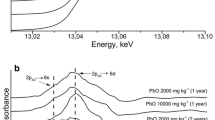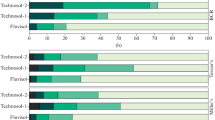Abstract
The chromate ore process residues (COPR) polluted soil was physically separated into coarse sand (2.000–0.425 mm), fine sand (0.425–0.053 mm) and silt to clay (< 0.053 mm) fractions. The Cr speciation was characterized by synchrotron based micro X-ray fluorescence (µ-XRF) and micro X-ray absorption near-edge spectra (µ-XANES). The results indicated that Cr was bearing both in COPR parent minerals and hydrated products and was dominated by Cr(III) in three size-fractions. The synchrotron results indicated that Cr(III) was dominated by chromite, organic matter bound Cr(III) and particle adsorbed Cr3+ in the selected hotspots from the coarse sand, fine sand and silt to clay sized fraction, respectively. While Cr(VI) occurred in the form of CrO42− in the selected hotspots from three size fractions. The difference of Cr(III) species in the size-fractions suggested that higher edaphic effects occurred in the fine size-fractions than in the coarse size-fraction for the weathered COPR.



Similar content being viewed by others
References
Choppala G, Kunhikrishnan A, Seshadri B, Park JH, Bush R, Bolan N (2018) Comparative sorption of chromium species as influenced by pH, surface charge and organic matter content in contaminated soils. J Geochem Explor 184:255–260
Chrysochoou M, Dermatas D (2006) Evaluation of ettringite and hydrocalumite formation for heavy metal immobilization: literature review and experimental study. J Hazard Mater 136:20–33
Chrysochoou M, Fakra SC, Marcus MA, Moon DH, Dermatas D (2009a) Microstructural analyses of Cr(VI) speciation in chromite ore processing residue (COPR). Environ Sci Technol 43:5461–5466
Chrysochoou M, Moon DH, Fakra S, Marcus M, Dermatas D, Christodoulatos C (2009b) Use of micro X-ray absorption spectroscopy and diffraction to delineate Cr(Vi) speciation In COPR. Global Nest J 11:318–324
Chrysochoou M, Dermatas D, Grubb DG, Moon DH, Christodoulatos C (2010) Importance of mineralogy in the geoenvironmental characterization and treatment of chromite ore processing residue. J Geotech Geoenviron 136:510–521
Darrie G (2001) Commercial extraction technology and process waste disposal in the manufacture of chromium chemicals from ore. Environ Geochem Health 23:187–193
Dermatas D, Bonaparte R, Chrysochoou M, Moon DH (2006) Chromite ore processing residue (COPR): hazardous contaminated soil or solid waste? J ASTM Int 3:13313
Ding WX, Stewart DI, Humphreys PN, Rout SP, Burke IT (2016) Role of an organic carbon-rich soil and Fe(III) reduction in reducing the toxicity and environmental mobility of chromium(VI) at a COPR disposal site. Sci Total Environ 541:1191–1199
Elzinga EJ, Cirmo A (2010) Application of sequential extractions and X-ray absorption spectroscopy to determine the speciation of chromium in Northern New Jersey marsh soils developed in chromite ore processing residue (COPR). J Hazard Mater 183:145–154
Geelhoed JS, Meeussen JCL, Hillier S, Lumsdon DG, Thomas RP, Farmer JG, Paterson E (2002) Identification and geochemical modeling of processes controlling leaching of Cr(VI) and other major elements from chromite ore processing residue. Geochimica Cosmochim Acta 66:3927–3942
Grafe M, Donner E, Collins RN, Lombi E (2014) Speciation of metal(loid)s in environmental samples by X-ray absorption spectroscopy: a critical review. Anal Chim Acta 822:1–22
Hawley EL, Deeb RA, Kavanaugh MC, et al. (2005) Treatment technologies for chromium(VI). In: Guertin J, Jacobs JA, Avakian CP (eds) Chromium(VI) handbook. CRC Press, Boca Raton, pp 275–309
Hillier S, Roe MJ, Geelhoed JS, Fraser AR, Farmer JG, Paterson E (2003) Role of quantitative mineralogical analysis in the investigation of sites contaminated by chromite ore processing residue. Sci Total Environ 308:195–210
Hillier S, Lumsdon DG, Brydson R, Paterson E (2007) Hydrogarnet: a host phase for Cr(VI) in chromite ore processing residue (COPR) and other high pH wastes. Environ Sci Technol 41:1921–1927
James BR (1996) The challenge of remediating chromium-contaminated soil. Environ Sci Technol 30:A248–A251
Matern K, Kletti H, Mansfeldt T (2016) Chemical and mineralogical characterization of chromite ore processing residue from two recent Indian disposal sites. Chemosphere 155:188–195
Moon DH, Wazne M (2011) Impact of brownmillerite hydration on Cr(VI) sequestration in chromite ore processing residue. Geosci J 15:287–296
Moon DH, Dermatas D, Wazne M, Sanchez AM, Chrysochoou M, Grubb DG (2007) Swelling related to ettringite crystal formation in chromite ore processing residue. Environ Geochem Health 29:289–294
Ohta A (2015) Speciation study of Cr in a geochemical reference material sediment series using sequential extraction and XANES spectroscopy. Geostand Geoanal Res 39:87–103
Rajapaksha AU, Alam MS, Chen N, Alessi DS, Igalavithana AD, Tsang DCW, Ok YS (2018) Removal of hexavalent chromium in aqueous solutions using biochar: chemical and spectroscopic investigations. Sci Total Environ 625:1567–1573
SEPA (State Environmental Protection Administration of China) (2007) Solid waste-extraction procedure for leaching toxicity sulphuric acid & nitric acid method (HJ/T299-2007). Beijing
US EPA (Unite States Environmental Protection Agency) (1996) Alkaline digestion for hexavalent chromium, Method 3060A. Washington, DC
Vodyanitskii YN (2013) Determination of the oxidation states of metals and metalloids: An analytical review. Eurasian Soil Sci 46:1139–1149
Xu HT, Lou TJ, Li YD (2004) Synthesis and characterize of trivalent chromium Cr(OH)3 and Cr2O3 microspheres. Inorg Chem Commun 7:666–668
Yu XL, Lu SG (2016) Multiscale correlations of iron phases and heavy metals in technogenic magnetic particles from contaminated soils. Environ Pollut 219:19–27
Acknowledgements
This research was funded by Zhejiang Agriculture and Forestry University Research Funding (2017FR021) and the National Natural Science Foundation of China (41771351). We are grateful to the beamline (BL15U1) of Shanghai Synchrotron Radiation Facility (SSRF) for providing µ-XRF and µ-XANES analysis. Thanks are also given to the anonymous reviewers for their suggestive comments on the paper improvement.
Author information
Authors and Affiliations
Corresponding author
Rights and permissions
About this article
Cite this article
Zhang, H., Zhou, B., Ren, J. et al. Chromium Speciation in the Size-Fractions of a Soil Polluted by Weathered Chromate Ore Process Residue Using Synchrotron X-ray Analysis. Bull Environ Contam Toxicol 103, 3–9 (2019). https://doi.org/10.1007/s00128-018-2399-0
Received:
Accepted:
Published:
Issue Date:
DOI: https://doi.org/10.1007/s00128-018-2399-0




